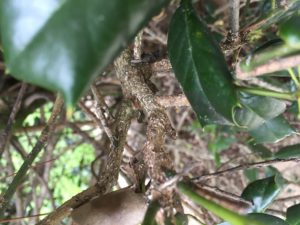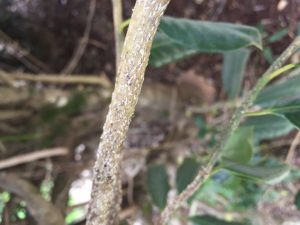Pest Alert – Japanese Maple Scale on Hollies
go.ncsu.edu/readext?740108
en Español / em Português
El inglés es el idioma de control de esta página. En la medida en que haya algún conflicto entre la traducción al inglés y la traducción, el inglés prevalece.
Al hacer clic en el enlace de traducción se activa un servicio de traducción gratuito para convertir la página al español. Al igual que con cualquier traducción por Internet, la conversión no es sensible al contexto y puede que no traduzca el texto en su significado original. NC State Extension no garantiza la exactitud del texto traducido. Por favor, tenga en cuenta que algunas aplicaciones y/o servicios pueden no funcionar como se espera cuando se traducen.
Português
Inglês é o idioma de controle desta página. Na medida que haja algum conflito entre o texto original em Inglês e a tradução, o Inglês prevalece.
Ao clicar no link de tradução, um serviço gratuito de tradução será ativado para converter a página para o Português. Como em qualquer tradução pela internet, a conversão não é sensivel ao contexto e pode não ocorrer a tradução para o significado orginal. O serviço de Extensão da Carolina do Norte (NC State Extension) não garante a exatidão do texto traduzido. Por favor, observe que algumas funções ou serviços podem não funcionar como esperado após a tradução.
English
English is the controlling language of this page. To the extent there is any conflict between the English text and the translation, English controls.
Clicking on the translation link activates a free translation service to convert the page to Spanish. As with any Internet translation, the conversion is not context-sensitive and may not translate the text to its original meaning. NC State Extension does not guarantee the accuracy of the translated text. Please note that some applications and/or services may not function as expected when translated.
Collapse ▲Japanese maple scale is showing up in more and more Henderson County landscapes. We have been seeing it on hollies. This tiny insect can also attack Japanese maple, red maple, dogwood, lilac, zelkova, yellowwood, pyracantha, privet, euonymus, redbud, stewartia, cherry, magnolia, and Itea.
Unlike other scale insects which suck the juices out of cells with needle-like mouthparts, this scale insect feeds directly on plant cells. Heavily infested trees slowly decline and eventually die. Home gardeners should prune out dead branches before baby scale insects hatch from eggs laid on the bark. This will reduce next year’s infestation.
When inspecting landscape trees and shrubs, look for tiny, almost microscopic white lines on the bark. These are the oyster shell-like covers that are excreted by the females. Baby insects (crawlers) can be seen using a hand lens moving along the bark in May or early June.
If you find these insects on your tree or shrub you will need to treat the insects. Applications of 0.5 – 1% horticultural oil and an insect growth regulator such as pyriproxyfen (Distance) or buprofezin (Talus) should be made to kill crawlers in May-June. This treatment should last for three weeks. If you see crawlers after three weeks, treat the tree again. Beneficial insects can significantly reduce scale populations but often are not sufficient.






